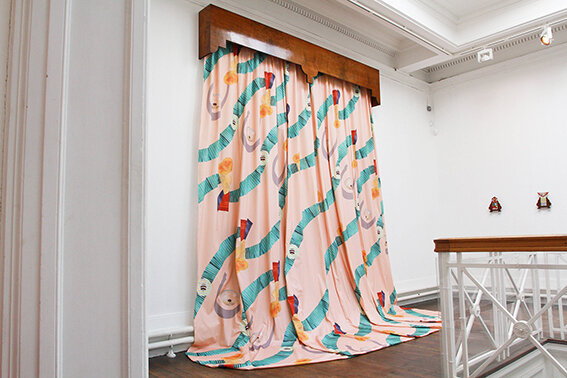An Architecture of Joy
Tom Emery
This essay was commissioned as part of the Looking Back/ Moving Forwards project, in conjunction with the exhibition An Architecture of Joy at Grundy Art Gallery, Blackpool, July 2016.
The seaside is an essential component of the British myth, an idea of a Britain that was, a wholesome escape from reality amongst the sand and the waves. Blackpool is the quintessential example of this, making the Grundy the ideal venue for Jenny Steele's An Architecture of Joy, the culmination of a long-running research project of Steele's into the Seaside Moderne architecture of 1930s British seaside towns. Steele cites examples such as Blackpool's own Pleasure Beach Casino, the Midland Hotel in Morecambe and the Rothesay Pavilion in the Isle of Bute as typifying this architectural genre. Buildings such as these are unmistakably modernist, but rather than the austere, hard-edged designs of Le Corbusier or Mies van der Rohe, there is a kitschy showmanship to their design, a flashy, art-deco glamour exemplified by the illuminated façade of the Pleasure Beach Casino, complete with its decorative tower evoking the form of a helter-skelter.
In reaction to this architecture, Steele produces a domestic scene of sorts, using found objects such as cabinets or photo frames, while creating curtains and wallpaper to complete the collection. This serves to bring the exhibition's themes down to a human scale, addressing the ambitious aims of Seaside Moderne architecture via objects such as the cabinet that forms the basis of The Apotheosis of Contemporary Design (2016). The size of this piece allows us as viewers to comprehend in its totality, rather than something as large and complex as an entire building.
The Apotheosis… forms a series of work incorporating found objects, alongside Not Just a Casino (2016) and two-part piece The Marriage (2016), both of which see Steele use art-deco frames to house her artistic interventions. In the case of The Apotheosis… and Not Just a Casino, Steele uses paint, applied directly to the surface of The Apotheosis's cabinet, while Not a Casino's frame performs its intended function by housing Steele's painting. While The Marriage is comprised of two matching freestanding frames that Steele has used to display embroidered pieces. With her painting and embroidery, Steele deploys a modernist/art deco iconography to complement these objects, turning them into vehicles for abstraction.
The final two pieces, The Sea Breeze was the Cure (2016) and A Restorative Resort (2016), see Steele greatly expand the scale of her work, while she also works entirely to her own designs, discarding the attachment to found objects. The wallpaper forming The Sea Breeze… and the curtains of A Restorative Resort again feature Steele's distinctive iconography, although in both examples, Steele more explicitly references Seaside Moderne with the architectural forms used in her designs.
The titles of these two pieces are particularly important in comprehending Steele's take on the seaside, with her use of words such as 'cure' and 'restorative' referencing the health benefits that a seaside holiday was supposed to provide. The Sea Breeze… and A Restorative Resort are then, explicitly optimistic pieces, envisioning a Blackpool that could once again be a positive influence on the body and the mind. This optimism is further demonstrated through the colour palettes of both pieces, with Steele's use of pink, yellow, sky blue and aquamarine radiating positivity, forming true representations of the exhibition title's 'architecture of joy'.
Unfortunately, this isn't reflected in Blackpool's present state. Blackpool is no longer what it once was, and while its tourist economy still thrives, much of the initial glamour has faded. Steele's A Restorative Resort capitalises on this contradiction between past and present with its Wizard of Oz effect; there's nothing behind the curtain. This glamorous, ceiling-to-floor design implies something more behind through its very form, but the reality cannot match up to the expectation. This is also found in The Apotheosis…, where the elegant frontage of the cabinet hides a backing that would have once been functional, if not beautiful, but that now can barely hold itself together.
This exhibition works best when its component parts overlap, when curtains or wallpaper become seamless additions to the gallery structure, or when a cabinet partially serves to draw focus to a painting mounted on the wall behind. This overlap is where Steele could push further, to use this attachment to the domestic in order to move into immersive environments as opposed to individual pieces. The use of found objects, as well as the creation of wallpapers and curtains already dilutes the barrier between art and design, but if this could be built upon to further break down barriers between singular objects/works of art, Steele's practice could become greater than the sum of its parts.
Tom Emery is a curator and writer based in Manchester.
